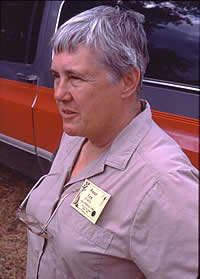
Spanish Colonial expert Anne Fox
from the University of Texas at San Antonio helped confirm
the identification of the mission.
Click images to enlarge
|
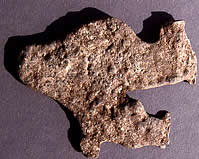
These pieces of melted lead from
the mission provide evidence of the fire that burned
the buildings down. Records and inventories indicate
that there were several soldiers stationed at the mission
to provide protection. They had lead with them for making
musket balls. Juan Leal was one of these soldiers.
|
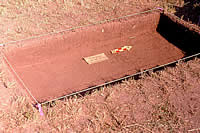
In this shallow archeological unit,
excavated out in the alfalfa field, a layer of lighter
soil at the top of the excavated surface indicates the
plow zone. This is the layer of soil turned over each
time the field is plowed or disked. Much of the original
deposit containing remains of the mission had been disturbed
by farming activities over the past century. Hall estimates
that, with another 20 years of plowing, all original
remnants of the mission, such as filled pits and post
stains, would have been destroyed.
|
|
All in all, the archeological findings at the mission
suggest that the depiction of the mission in the Terreros
mural is fairly accurate.
|
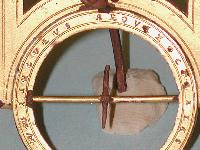
Close up of the universal equinoctial
sundial. It was half of a two-part navigational instrument.
The missing part is the compass upon which the sundial
sat. Photo by Donny Hamilton.
|
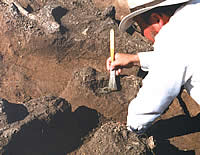
Archeologist Elton Prewitt uncovering
the sundial.
|
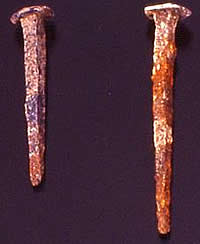
Hand-wrought nails and spikes.
|
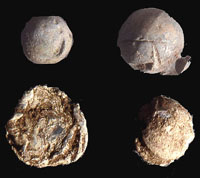
Musket balls.
|

Gunflints and Guerrero arrow point.
The Indians were completely dependent on Europeans for
muskets, lead shot, and gunpowder. One thing they could
make for themselves, though, were the gunflints needed
to ignite the powder when a musket was fired. Some examples
of so-called "native" gunflints are shown
here, along with an unstemmed arrow point of the type
that Texas Indians made during the time they were in
the Spanish missions.
|
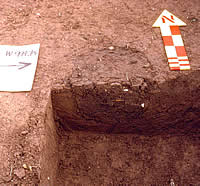
Post stain. By mapping all of the
burned post stains found at the mission, we were able
to trace the outlines of the stockade and the houses
and church inside.
|
|
Following the initial discovery of the mission
in September of 1993, Grant Hall, Kay Hindes, and Mark Wolf
organized a testing program funded by the Texas Historical
Foundation, the Lende Foundation, and Bob and Kathleen Gilmore.
Testing of the site was done in late 1993 and early 1994 by
Hall, with the assistance of students from Texas Tech University
and various archeological colleagues. Spanish Colonial expert
Anne Fox from the University of Texas at San Antonio lined
up a group of metal detector operators, all members of the
Southern Texas Archeological Association. Led by Tommy Tomesal,
this group used the detectors very productively to locate
a number of musketballs, nails, brass artifacts, and other
Spanish artifacts across the mission site. The location of
each item was carefully plotted on a map.
Test excavations scattered around the site revealed
that much of the original soil deposits and land surface upon
which the mission was built had been cut away or churned up
by farming activities on the land from about 1900 up to the
present. At first we feared that all signs of the mission
had been completely destroyed by plowing. Fortunately, as
testing progressed, we began to find stains representing the
posts used to build the mission stockade, church, and other
buildings. These stains, consisting of ash, charcoal, and
burned soil, marked the spots where wooden posts had burned
down into the ground. The wood itself was gone, but the ash
and charcoal showed where each post had been, and gave us
its approximate diameter.
The test excavations carried out in 1993 and
1994 verified that the site was indeed that of Mission San
Sabá. Though heavily damaged by plowing, there was
still buried evidence in Judge Lyckman's alfalfa field that
could tell a good bit about the configuration of the mission.
But this would require a major excavation and that meant we
needed support. This is often the most difficult obstacle
to overcome for archeologists undertaking pure research projects
and it is something many people don't understand. Major archeological
investigations, even if done with the assistance of volunteers
and students, are time-consuming and costly. A proper investigation
involves a lot more than digging. It takes specialists in
many fields working before, during, and after the excavation.
And the responsibility of the lead investigator is not completed
until a full scientific report is published.
1997 Dig
In 1997, with funding from the Summerlee Foundation
and other benefactors, Texas Tech archeologists returned to
the mission for a full-scale excavation. Once again the team
included a mix of professional archeologists, students, and
volunteers. Realizing the upper soil deposits were churned
by farming, the decision was made to use a small trackhoe
to strip off the disturbed soil. Once this "plow zone"
was removed, we quickly were able to locate and excavate the
post stains and features lying beneath. This approach proved
to be very effective in exposing roughly 100 post stains and
about 30 archeological features. Along the south side of the
field, a narrow strip of the original ground surface was preserved,
protected by a fence line. There, careful hand excavations
took place.
The post stains, when plotted out on a map,
revealed a trapezoidal outline shape to the mission stockade,
with the broad end to the west. This side was about 160 feet
in length. The north wall, clearly visible, was about 130
feet in length. The east and south walls of the stockade were
not as easy to make out. However, we speculate that the east
wall was shorter than the west, and ran parallel to it. The
south wall was probably the same length as the north wall.
Within the stockade, we found post stains that
we think represent the church. These defined a building oriented
with the long axis east-west, having dimensions of roughly
35 by 50 feet. The belief that this was the church is supported
by the fact that it was out in front of the traces of other,
smaller buildings. Lead musket balls were concentrated around
it, consistent with the stand that Juan Leal and the other
survivors made in the church. The Indians appear to have fired
many musket shots at the defenders within the church. Another
find was that of an empty grave at the west end of the stains
representing the church. All that was found in this grave
were a human finger bone, a couple of teeth, and a number
of green-glass seed beads. We assume that the body the grave
once contained was disinterred and removed to another location
following the 1758 attack.
Along the south wall, on the inside of the stockade,
were post stains representing at least five small buildings.
The largest measured about 14 feet in width and 20 feet in
length. These were probably the house of the priests and soldiers,
storerooms, and kitchens. All in all, the archeological findings
at the mission suggest that the depiction of the mission in
the Terreros mural is fairly accurate.
In addition to the empty grave associated with
the church, there was another particularly interesting feature
found in what would have been the northwest corner of the
stockade. This was a pit that contained quite a few oxen bones,
horns, and horn cores. The survivors of the attack said that
the Indians killed all of the livestock at the mission. Later,
they roasted and ate the meat of the oxen. We think this pit
containing the oxen bones was the barbeque pit where the Indians
did their cooking to celebrate their victory.
Amid the bones in the barbeque pit, we made
a most unexpected and unusual discovery—that of a small
gold-plated brass pocket sundial bearing the date 1580, some
177 years before the sacking of the mission. This artifact
is one of the earliest scientific instruments of its type—a
universal equinoctial sundial. This sundial was once part
of a two-part navigational instrument. The missing part is
a compass upon which the sundial sat. How this specialized
and rare item found its way to Mission San Sabá and
into the pit with the cattle bones is a complete mystery.
It was obviously a heirloom item, one that must have belonged
to a well-to-do person. Given its striking appearance, it
seems odd that the Indians didn't carry it off. Perhaps it
was lost amid the celebration.
Another mystery remains concerning the mission.
When the Spanish soldiers returned to the scene of death and
destruction several days after the attack, they buried the
two priests and several other men who had been killed and
burned in the Holy Ground by the church. These graves still
have not been found. A couple of explanations come to mind.
Since the bodies were badly decomposed, the graves may have
been dug quickly and were therefore shallow. They may well
have been destroyed by farming in the twentieth century. A
second possibility is that the bodies were later disinterred
from the graves and taken to the San Sabá Presidio
cemetery, or perhaps back to Mexico. This latter explanation
is consistent with the finding of the emptied grave and seems
the most likely.
The Indians who attacked the San Sabá
Mission in 1758 were unusual for their time in that they were
equipped with firearms, swords, armor and other European weapons.
They obtained these from the French, who then occupied Louisiana
and had hopes of taking over Spanish territory in Texas, in
exchange for buffalo, deer, and other hides and furs. The
French knew that the Indians would use the firearms against
the Spaniards. When the Indians attacked the mission, it was
the first time that the Spaniards had come up against a force
of Native Americans armed with muskets. The many lead musket
balls found at the mission were concentrated in the area of
the site where the church had been. This was the building
where Juan Leal and the other survivors had held out until
nightfall, when they escaped the burning mission and made
it to the safety of the presidio. It is easy to imagine the
Indians circling the church (at a safe distance, because Juan
Leal and the others were firing their muskets at the Indians)
and firing musket shots into its walls in hopes of killing
the Spaniards within.
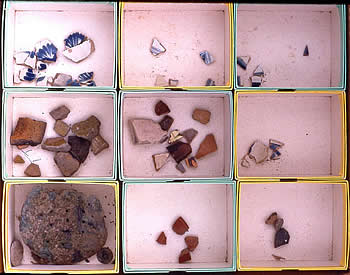 Spanish pottery.
|
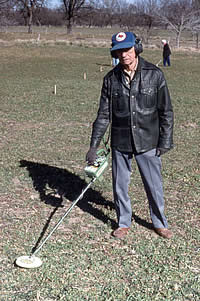
Tommy Tomesal, leader of a group
of metal detector operators, all members of the Southern
Texas Archeological Association. Tomesal's group used
their metal detectors very productively to locate a
number of musketballs, nails, brass artifacts, and other
Spanish metal artifacts across the mission site.
|
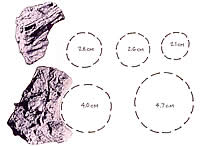
Some daub specimens allowed us to
calculate the diameters of wooden poles that formed
the walls of the buildings inside the mission.
|
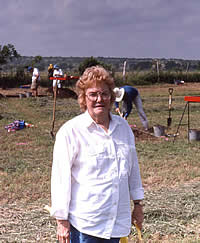
Dr. Kathleen Gilmore at the San Sabá
Mission in 1993. A noted authority on the Spanish colonial
era in Texas, she was the first to search for the location
of the mission in the mid-1960s. Her work served as
a foundation for all later efforts to find the mission.
|
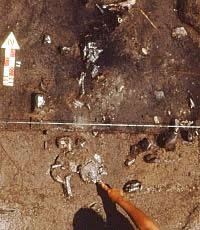
This dark-stained area was either
a cooking pit or trash pit containing animal bones,
burned rock, and other debris relating to life in the
mission, prior to the attack. A surprising find amidst
the other bones was a fragment of a human cranium, which
is being pointed out in this photograph. It is a mystery
as to why human skeletal remains would be found in this
feature.
|
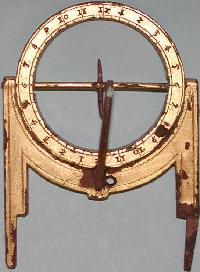
Gold-plated, brass pocket sundial
bearing the date 1580 found in a barbeque pit amid the
bones of oxen slaughtered and cooked by the victorious
Indians. This rare and extremely well preserved artifact
was conserved by Dr. Donny Hamilton of Texas A&M
University who reports that the brass alloy had a high
percentage of copper. Photo by Donny Hamilton.
|
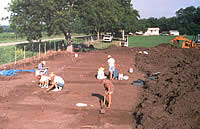
View west of 1997 excavations. Pink
flags mark post stains and foundation trench lines of
six small houses built within the stockade on the south
side of the mission compound. The trackhoe, the machine
used to removed the plow zone, is visible on the right.
|
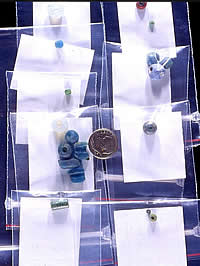
Glass beads. The Spanish priests
brought hundreds of necklaces made of green and blue
glass beads to give to the Indians. These beads were
manufactured in Europe. Following the attack on the
mission, the Indians carried away many of the necklaces,
but quite a few of the beads were scattered around the
site to be found by archeologists.
|
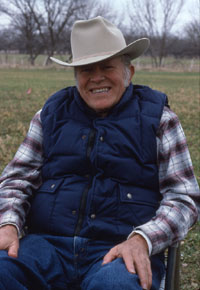
Another authority on the Spanish colonial
era in Texas, the late Curtis Tunnell visited the San
Sabá Mission excavations in 1994. Tunnell conducted
excavations at the site of Mission San Lorenzo de la Santa
Cruz, located about 90 miles south of San Sabá
on the Nueces River near present-day Camp Wood, Texas.
Following the failure of the San Sabá Mission,
the Spanish priests and soldiers learned that the Apache
Indians would be more likely to live in a mission in the
more familiar Nueces River country. Nonetheless, Mission
San Lorenzo also ended as a failure, albeit not in as
spectacular a fashion.
|
|